Kristine Hughes's Blog, page 122
August 4, 2012
Britain Magazine: the Official Guide
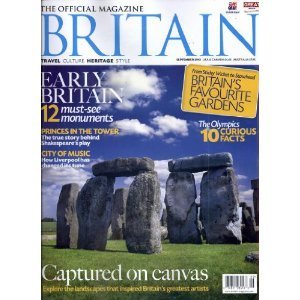 September 2012 issue
September 2012 issueVictoria here, writing again about favorite magazines. Besides watching the BBC news and listening too, via public stations here in the U.S., I stay close to Britain while I am home by reading lots of magazines, many from the UK. Every two months, Visit Britain, the official tourism agency, publishes a glossy issue filled with travel suggestions, sumptuous pictures and tempting ads, aka gift ideas. Sigh.

The latest issue to arrive is dated September 2012 and has many interesting articles, from ice age cave-dwellers to the Princes in the Tower to this summer's favorite gardens.
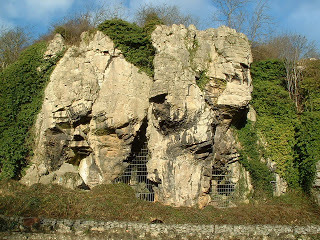 Creswell Crags
Creswell Crags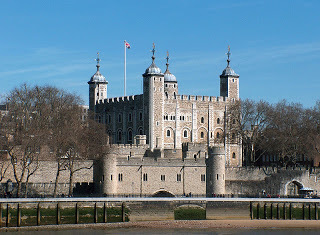 Tower of London
Tower of London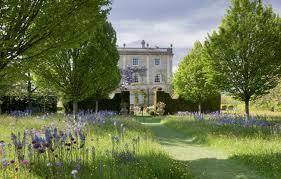 Highgrove House and Gardens
Highgrove House and GardensIt's a wonderful mix of history and scenery, castles and stately homes, villages and cities. The website, too, is excellent and could occupy you for a long afternoon of dreaming, here. Subscriptions are available and the magzine can be found in most bookstores and newstands.
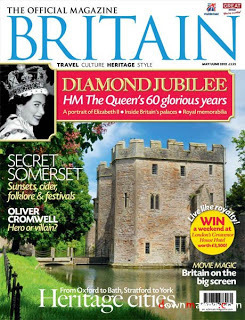 July 2012 issue
July 2012 issueAs you might have expected, the July issue of Britain had a major feature on The Diamond Queen, to celebrate Elizabeth II's sixty years on the throne.
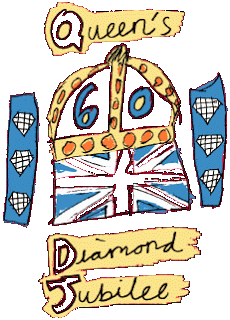
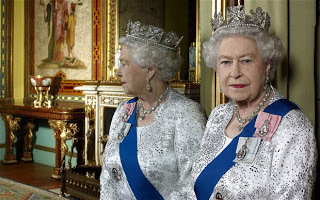
Other topics were the county of Somerset (Land of the Summer People), Royal Memorabilia, Inside Britain's Palaces, and Britian's Most Eccentric Events. You can read the latter here.
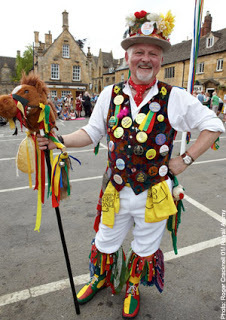 A Morris Dancer in Chipping Campden
A Morris Dancer in Chipping CampdenYou also have the opportunity to win weekends at posh hotels and tours -- and if your letter to the magazine is chosen as the month's favorite, you win a special prize. But best of all is the material for dreams...and planning that next trip.
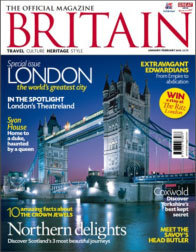
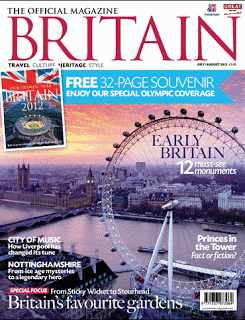
/[image error]
Published on August 04, 2012 01:00
August 2, 2012
A Couple In England
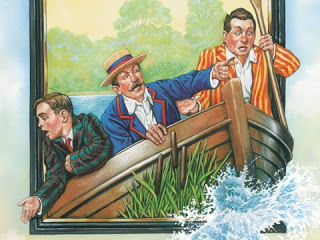
Recently, I was reading Jerome K. Jerome's Three Men In A Boat when I came upon the following passage:
"What we want is rest," said Harris. "Rest and a complete change," said George. "The overstrain upon our brains has produced a general depression throughout the system. Change of scene, and absence of the necessity for thought, will restore the mental equilibrium." George has a cousin, who is usually described in the charge-sheet as a medical student, so that he naturally has a somewhat family-physicianary way of putting things.I agreed with George, and suggested that we should seek out some retired and old-world spot, far from the madding crowd, and dream away a sunny week among its drowsy lanes—some half-forgotten nook, hidden away by the fairies, out of reach of the noisy world—some quaint-perched eyrie on the cliffs of Time, from whence the surging waves of the nineteenth century would sound far-off and faint."
As I've recently been feeling the strain of a maternal broken hip, and as the exact meaning of the phrase "beck and call" has been made crystal clear to me in recent weeks, you can imagine the effect the above passage had upon my fatigued psyche. I agreed with every word I'd read, save for the bit about putting the nineteenth century far off.
Needing to get away, the three men in question eventually hit upon a fortnight's boat trip as the answer to their problems. Unfortunately, rowing myself and my husband up and down the Thames held no appeal for me, so it became necessary for me to come up with an alternate itinerary. Naturally, the words "some retired and old-world spot" put me in mind of London. While the City might not, nowadays, be universally described as "far from the madding crowd," I felt sure that my little bit of Mayfair and St. James's would prove as soothing as ever. And nothing manages to calm my nerves more than a visit to Apsley House.
"Drowsy lanes - some half-forgotten nook . . . " You may be sure that I gave this turn of phrase some thought. If I were a pipe smoking sort of lady, I'd have fired up a bowlful whilst ruminating on the myriad English places that fit this description. Where existed drowsy lanes? I must admit, I got caught up on this one for a time, since there are endless possibilities. However, I then re-read the passage and saw again the "half-forgotten nook." By Jove, we'd go to Bath! Half forgotten, indeed, as so much of the City remains as it was in a long forgotten time, said time being the Georgian period. Yes, Bath would do nicely, I thought.
Finally, I considered "some quaint-perched eyrie on the cliffs of Time," which proved easily deciphered, as Windsor Castle, whilst not precisely on a cliff, is as quaint an eyrie as anyone might want. And practically speaking, if we circled back round for a stay in Windsor as the last leg of our visit, we should be ideally placed for the flight home.
Having determined our itinerary, I then informed my husband that we are going to London, Bath and Windsor at Christmas time. My husband is a study in understatment - so dignified, so reserved. And what a sense of humour! Where you or I would, upon hearing this marvelous news, have gushed and, at the very least, jumped for joy, my husband managed, no doubt by Herculean effort, to contain his excitement and offered me instead an admirably conservative, "Oh, eh?"
I could tell that the husband was giving the proposed itinerary a goodly amount of thought. He tried to play it cool by keeping his eyes glued upon the t.v. and Pardon The Interruption, but after a time he turned towards me and asked what Bath was, what was there and why, exactly, we were going there. What a card!
I did get a rise out of him after I'd explained that we'd be doing a full Wellington day whilst in London - Apsley House, the Wellington Arch, Horse Guards and the daily 3 p.m. parade inspection, a stop by the Wellington Barracks and the Guards Museum, tea at the Langham, dinner at the Duke of Wellington pub and a night cap at the Grendadier. After hearing absolutely every last detail of my plans for a day simply steeped in Wellingtonia, my husband was so overcome with anticipation that the only words he could muster were "Oh. Joy."
I can only imagine what his response would have been to my proposing that he paddle us up and down the Thames for two weeks.[image error]
Published on August 02, 2012 00:33
July 30, 2012
Royal Albert Hall, Since 1871
[image error]
Royal Albert Hall, website here
On my very first trip to London -- so long ago I dare not reveal the year -- I attended a concert at this venerable institution. Being a student and nearly penniless as were my companions, we sat way up at the top in the cheapest seats. Sad to say I don't remember anything about the music we heard, but I will never forget the view of the vast auditorium packed with cheering fans. For what, I couldn't say, though I assume it was one of the Proms.
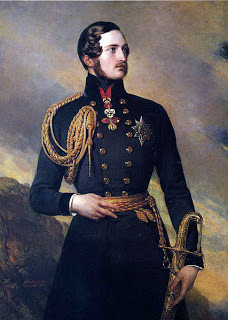 Prince Albert, by F. X. Winterhalter
Prince Albert, by F. X. Winterhalter
Prince Albert (of Saxe-Coburg and Gotha, 1819-1861) carved out a place in British history both as the Prince Consort who assisted his wife Queen Victoria in many ways, and as a promoter of science and technology developments. He was the mover and shaker behind the Great Exhibition of 1851 and the development of South Kensington, which came to be known as Albertopolis, into a center of education, scientific and cultural development.
[image error] map showing the institutions of South Kensington/Albertopolis
For a fuller exploration of the architecture of the area, consult the Royal Institute of British Architects here.
Many now-great institutions grew here on the site of an agricultural oasis up to the mid-19th century: the Natural History Museum...
[image error] Natural History Museum, Cromwell Roadwebsite here
... the Science Museum,
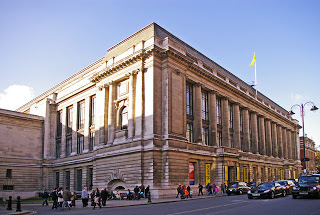 Science Museum, Exhibition Road Website here
Science Museum, Exhibition Road Website here
... the Imperial College London, the Royal Geographical Society, the Royal College of Art, and the Royal College of Music. The Victoria and Albert Museum, sprawling repository of great works of the decorative arts is the eastern most part of the neighborhood.
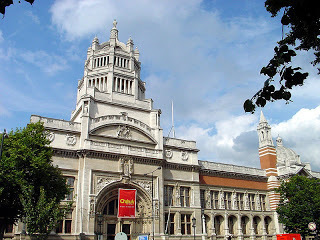 Victoria and Albert Museum, Cromwell RoadWebsite here
Victoria and Albert Museum, Cromwell RoadWebsite here
[image error] Victoria and Albert Museum Entry
Northern most of the complex is the Albert Memorial, recently renovated, in Kensington Gardens opposite Royal Albert Hall. Sir George Gilbert Scott designed the Gothic structure, dedicated by Queen Victoria in 1872.
[image error] Albert Memorial
[image error] Prince Albert
Getting back to Royal Albert Hall, it was begun in 1867 and dedicated by Queen Victoria in 1871. The design was conceived by Henry Cole, who was inspired by ancient Roman amphitheatres; the details were worked out by two Royal Engineers, Captain Francis Fowle and General Henry D. Scott. The vast central auditorium is elliptical in shape, about 185 feet wide and 219 feet long; it can be reconfigured for many types of events both with traditional staging and in the round.
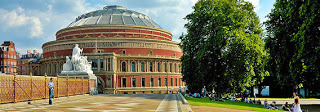
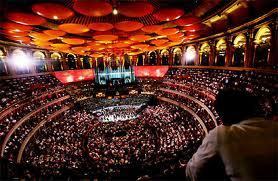 Take a Virtual Tour of Royal Albert Hall here.
Take a Virtual Tour of Royal Albert Hall here.
Funds for building the Hall came partially from profits of the 1851 Great Exhibition in Hyde Park. Prince Albert suggested that the area of South Kensington be filled with institutions to promote education and progress, but he died before the scheme was completed.
For a full timeline of the construction of the Hall and many of the events held there, click here.
Among the many stray facts about the Hall is the number of red bricks used: 6,000,000. Originally it was lit by gas, which was replaced by full electric lighting in 1888. Only minor damage to Royal Albert Hall occurred in Word War II; it was said that the German pilots, as they did for St. Paul's Cathedral, left it alone because its distinctive appearance served as a landmark for their bombing runs. Refurbishment took place in 1996-2004, with the addition of many modern conveniences, upgrading the restaurant facilities and other amenities.
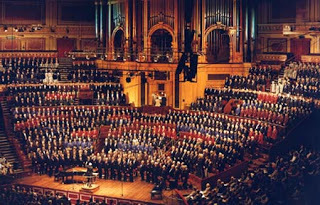 massed choirs in the RAH
massed choirs in the RAH
Royal Albert Hall was purposely designed to adapt to all sorts of events, concerts, conferences, speeches, meetings, ceremonies, exhibitions, sporting events (tennis, wrestling, boxing) and even the circus. Classical, opera, jazz, folk, rock and pop concerts have included the most famous performers in the world. Verdi, Wagner and Elgar all conducted their works at the RAH. The list of stars who have play the Hall would illuminate not only the vast dome but the entire sky above.
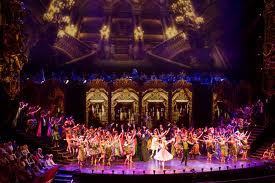 Phantom of the Opera 25th Anniversary, 2011
Phantom of the Opera 25th Anniversary, 2011
Royal Albert Hall is held in trust for the nation of Great Britain but it operates entirely on its own earned funding. Many educational programs are operated in collaboration with schools and other institutions. Even if the hall is "dark" when you visit, you can book a tour.
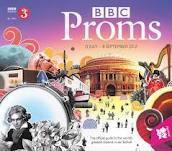
The annual 8-week program of BBC Proms will run through Saturday, September 8, 2012. For more info in the Proms, click here.
Rock on, RAH![image error]
On my very first trip to London -- so long ago I dare not reveal the year -- I attended a concert at this venerable institution. Being a student and nearly penniless as were my companions, we sat way up at the top in the cheapest seats. Sad to say I don't remember anything about the music we heard, but I will never forget the view of the vast auditorium packed with cheering fans. For what, I couldn't say, though I assume it was one of the Proms.
 Prince Albert, by F. X. Winterhalter
Prince Albert, by F. X. WinterhalterPrince Albert (of Saxe-Coburg and Gotha, 1819-1861) carved out a place in British history both as the Prince Consort who assisted his wife Queen Victoria in many ways, and as a promoter of science and technology developments. He was the mover and shaker behind the Great Exhibition of 1851 and the development of South Kensington, which came to be known as Albertopolis, into a center of education, scientific and cultural development.
[image error] map showing the institutions of South Kensington/Albertopolis
For a fuller exploration of the architecture of the area, consult the Royal Institute of British Architects here.
Many now-great institutions grew here on the site of an agricultural oasis up to the mid-19th century: the Natural History Museum...
[image error] Natural History Museum, Cromwell Roadwebsite here
... the Science Museum,
 Science Museum, Exhibition Road Website here
Science Museum, Exhibition Road Website here... the Imperial College London, the Royal Geographical Society, the Royal College of Art, and the Royal College of Music. The Victoria and Albert Museum, sprawling repository of great works of the decorative arts is the eastern most part of the neighborhood.
 Victoria and Albert Museum, Cromwell RoadWebsite here
Victoria and Albert Museum, Cromwell RoadWebsite here[image error] Victoria and Albert Museum Entry
Northern most of the complex is the Albert Memorial, recently renovated, in Kensington Gardens opposite Royal Albert Hall. Sir George Gilbert Scott designed the Gothic structure, dedicated by Queen Victoria in 1872.
[image error] Albert Memorial
[image error] Prince Albert
Getting back to Royal Albert Hall, it was begun in 1867 and dedicated by Queen Victoria in 1871. The design was conceived by Henry Cole, who was inspired by ancient Roman amphitheatres; the details were worked out by two Royal Engineers, Captain Francis Fowle and General Henry D. Scott. The vast central auditorium is elliptical in shape, about 185 feet wide and 219 feet long; it can be reconfigured for many types of events both with traditional staging and in the round.

 Take a Virtual Tour of Royal Albert Hall here.
Take a Virtual Tour of Royal Albert Hall here.Funds for building the Hall came partially from profits of the 1851 Great Exhibition in Hyde Park. Prince Albert suggested that the area of South Kensington be filled with institutions to promote education and progress, but he died before the scheme was completed.
For a full timeline of the construction of the Hall and many of the events held there, click here.
Among the many stray facts about the Hall is the number of red bricks used: 6,000,000. Originally it was lit by gas, which was replaced by full electric lighting in 1888. Only minor damage to Royal Albert Hall occurred in Word War II; it was said that the German pilots, as they did for St. Paul's Cathedral, left it alone because its distinctive appearance served as a landmark for their bombing runs. Refurbishment took place in 1996-2004, with the addition of many modern conveniences, upgrading the restaurant facilities and other amenities.
 massed choirs in the RAH
massed choirs in the RAHRoyal Albert Hall was purposely designed to adapt to all sorts of events, concerts, conferences, speeches, meetings, ceremonies, exhibitions, sporting events (tennis, wrestling, boxing) and even the circus. Classical, opera, jazz, folk, rock and pop concerts have included the most famous performers in the world. Verdi, Wagner and Elgar all conducted their works at the RAH. The list of stars who have play the Hall would illuminate not only the vast dome but the entire sky above.
 Phantom of the Opera 25th Anniversary, 2011
Phantom of the Opera 25th Anniversary, 2011Royal Albert Hall is held in trust for the nation of Great Britain but it operates entirely on its own earned funding. Many educational programs are operated in collaboration with schools and other institutions. Even if the hall is "dark" when you visit, you can book a tour.

The annual 8-week program of BBC Proms will run through Saturday, September 8, 2012. For more info in the Proms, click here.
Rock on, RAH![image error]
Published on July 30, 2012 23:05
July 28, 2012
From the August 1801 Annual Register
Like many writers who dote on the late Georgian period, I have a selection of publications called Annual Registers, which are something like almanacks. They contain a wide variety of articles, from serious accounts of international diplomacy to gossip and on-dits about unusual incidents. Here are three items from The Annual Register, or A View of the History, Politics, and Literature for the Year 1801, from the Chronicle for August p.47-48:
"1st As the Marquis of Abercorn was driving the Marchioness and Lady Catharine Hamilton in a curricle, near Stanmore, the horses took fright, and set off at full speed;
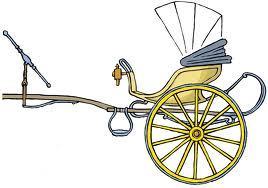 Curricle
Curricle
... in the attempt to pull them up, the reins snapped. The Marquis, embarrassed by the shrieks of the ladies, and unsteady in his seat, jumped into the road and broke his right thigh and left leg.
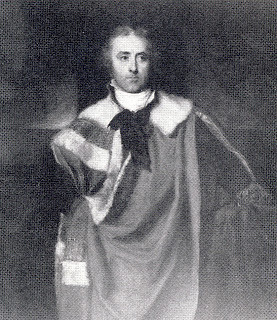 John James Hamilton, 1st Marquis of Abercorn (1756-1818)
John James Hamilton, 1st Marquis of Abercorn (1756-1818)
The ladies kept their seats until the coachman, who was outrider, saw a convenient place, when, by forcing the horses towards the ditch, he contrived to have them thrown out upon the bank without injury. The horses again set off.
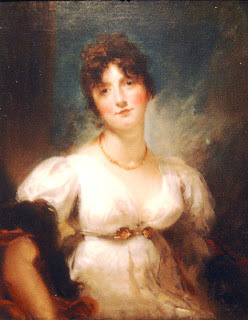 Lady Anne Jane Gore, Marchioness of Abercorn, 3rd wife of the 1st Marquis (d. 1827)ca. 1800, New Orleans Museum of Art
Lady Anne Jane Gore, Marchioness of Abercorn, 3rd wife of the 1st Marquis (d. 1827)ca. 1800, New Orleans Museum of Art
The curate of Edgware coming along the road, made an attempt to stop them, but unfortunately lost the cap of his knee by a blow of the pole. A surgeon set the Marquis’s limb upon the spot."
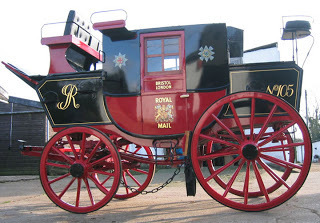 Royal Mail Coach, 1800
Royal Mail Coach, 1800
"At the Maidstone Assizes, on Thursday last, James and John Austin, brothers, were put to the bar on a charge of robbing the mail...from both of which they obtained a large booty, notes to a great amount having been paid previous to the discovery of those by whom the robbery had been perpetrated....It was proved that this bundle of notes consisted of the paper of different country banks, which had been stolen from the mails, and thus there was no doubt of the connection of this prisoner with the robbery....After all the various proofs of these facts had been minutely gone through, the jury brought in a verdict, acquitting the prisoner John, but finding James guilty.
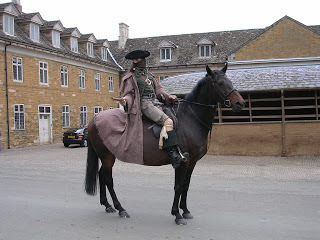 A Highwayman Re-enactor, near Belvoir Castle
A Highwayman Re-enactor, near Belvoir Castle
The judge immediately pronounced sentence of death on the prisoner, adjudging him to be hanged in chains near the place where the robbery was committed....he confessed he was concerned in the robbery...at the same time confessed having stolen many letters and parcels while he was post-boy at Lamberhurst in Kent...."
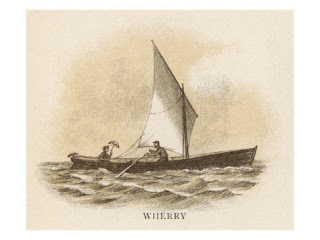 Thames Wherry
Thames Wherry
"August 5th As a party of ladies and gentlemen were amusing themselves in a wherry on the Thames near Shepperton, a salmon leaped from the river and fell into the boat. In the struggle to seize the fish, the wherry was precipitated down the stream, and was at length overturned; but, the place was fortunately so shallow, that none of the parties were drowned, though they were immersed head over ears in the water. Mr. Smith, who saw the accident, induced the party to accompany him to his hospitable mansion where a change of clothes was procured for the unfortunate party, but the lady of Mr. Maintone, who was far advance in pregnancy, was seized with violent convulsions, in consequence of the fright, and expired before morning."
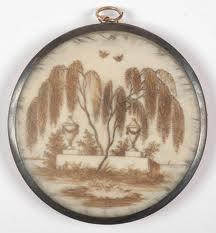 Mourning Symbols[image error]
Mourning Symbols[image error]
"1st As the Marquis of Abercorn was driving the Marchioness and Lady Catharine Hamilton in a curricle, near Stanmore, the horses took fright, and set off at full speed;
 Curricle
Curricle... in the attempt to pull them up, the reins snapped. The Marquis, embarrassed by the shrieks of the ladies, and unsteady in his seat, jumped into the road and broke his right thigh and left leg.
 John James Hamilton, 1st Marquis of Abercorn (1756-1818)
John James Hamilton, 1st Marquis of Abercorn (1756-1818)The ladies kept their seats until the coachman, who was outrider, saw a convenient place, when, by forcing the horses towards the ditch, he contrived to have them thrown out upon the bank without injury. The horses again set off.
 Lady Anne Jane Gore, Marchioness of Abercorn, 3rd wife of the 1st Marquis (d. 1827)ca. 1800, New Orleans Museum of Art
Lady Anne Jane Gore, Marchioness of Abercorn, 3rd wife of the 1st Marquis (d. 1827)ca. 1800, New Orleans Museum of ArtThe curate of Edgware coming along the road, made an attempt to stop them, but unfortunately lost the cap of his knee by a blow of the pole. A surgeon set the Marquis’s limb upon the spot."
 Royal Mail Coach, 1800
Royal Mail Coach, 1800"At the Maidstone Assizes, on Thursday last, James and John Austin, brothers, were put to the bar on a charge of robbing the mail...from both of which they obtained a large booty, notes to a great amount having been paid previous to the discovery of those by whom the robbery had been perpetrated....It was proved that this bundle of notes consisted of the paper of different country banks, which had been stolen from the mails, and thus there was no doubt of the connection of this prisoner with the robbery....After all the various proofs of these facts had been minutely gone through, the jury brought in a verdict, acquitting the prisoner John, but finding James guilty.
 A Highwayman Re-enactor, near Belvoir Castle
A Highwayman Re-enactor, near Belvoir Castle The judge immediately pronounced sentence of death on the prisoner, adjudging him to be hanged in chains near the place where the robbery was committed....he confessed he was concerned in the robbery...at the same time confessed having stolen many letters and parcels while he was post-boy at Lamberhurst in Kent...."
 Thames Wherry
Thames Wherry "August 5th As a party of ladies and gentlemen were amusing themselves in a wherry on the Thames near Shepperton, a salmon leaped from the river and fell into the boat. In the struggle to seize the fish, the wherry was precipitated down the stream, and was at length overturned; but, the place was fortunately so shallow, that none of the parties were drowned, though they were immersed head over ears in the water. Mr. Smith, who saw the accident, induced the party to accompany him to his hospitable mansion where a change of clothes was procured for the unfortunate party, but the lady of Mr. Maintone, who was far advance in pregnancy, was seized with violent convulsions, in consequence of the fright, and expired before morning."
 Mourning Symbols[image error]
Mourning Symbols[image error]
Published on July 28, 2012 23:48
July 27, 2012
Fashion Museums in Britain
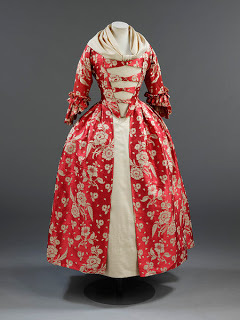 Red Silk Robe a l'Anglaise, Victoria and Albert Museum, 1760's
Red Silk Robe a l'Anglaise, Victoria and Albert Museum, 1760'sVictoria here, taking some time off of Pinterest for a change...and ruminating on the wonderful fashion museums which have so carefully preserved the clothing and accessories of bygone eras. The U.K. is replete with wonderful museums, almost all of which have some fashions, in even the smallest of local collections. The grandaddy of them all is, of course, The Victoria and Albert Museum in London, which modestly calls itself, "The world's greatest museum of art and design." The website is here.
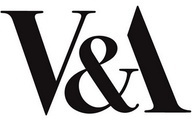
I suppose no one who has visited the sprawling site on Cromwell Road would quarrel with the designation, for it is truly superhuman to cover its many displays even in multiple visits.I can hardly drag myself out of the fantastic gift shop when I get there!
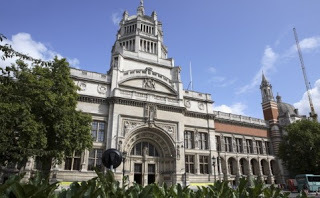
Would you be disappointed if I did not include a link to that wonderful shop? Be forewarned -- they are excellent at shipping. Click here -- if you dare.
The Costume Collection has been recently redone and has re-opened with an exhibition of ball gowns from the 1950s to the present. It will be on display through January 2013, along with selections from the permanent collection of historic fashions.
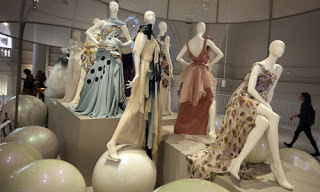
I love the Georgian, Regency and Victorian gowns usually on view. Due to their fragility, the items are frequently rotated from storage to display and back.
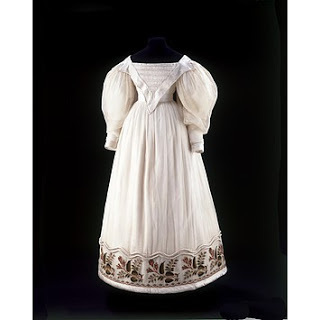 V and A: White Dress with scalloped hem, ca. 1830British, cotton muslin with wool embroidery, silk, satin and wadded rouleaux
V and A: White Dress with scalloped hem, ca. 1830British, cotton muslin with wool embroidery, silk, satin and wadded rouleaux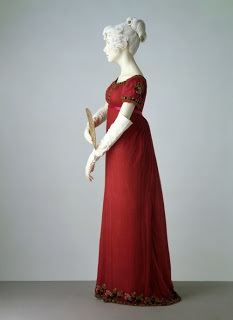 V and A: Evening Dress, 1807-11 British, machine made silk net, embroidered with chenille thread, with silk ribbon, hand sewn; over red petticoat
V and A: Evening Dress, 1807-11 British, machine made silk net, embroidered with chenille thread, with silk ribbon, hand sewn; over red petticoat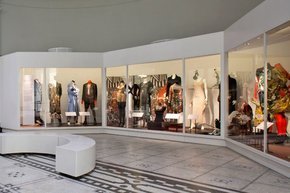 Among the V and A's fashion exhibits
Among the V and A's fashion exhibitsAlso in London, Kensington Palace stores, conserves and exhibits Historic Royal Fashions. Recently, the collection of Royal Wedding Gowns was restored. Beginning this fall, some of the storage areas, formerly Princess Margaret's Apartment 1A, will be renovated for Prince William, Duke of Cambridge, and his Duchess, the former Catherine Middleton.
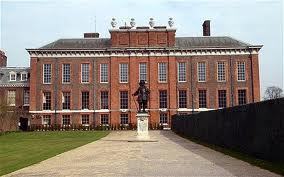
Parts of Kensington Palace formerly housed Diana, Princess of Wales, and is the home in which Prince William grew up. Other members of the extended royal family also have quarters there.
Here is an article that tells more about the Palace, the renovations and the Royals. For more details, click here.
Parts of Kensington Palace include the State Rooms of William and Mary, the childhood rooms of Queen Victoria, and the Royal Fashions. I have not seen an announcement of the final plans for the fashions, but one assumes that Historic Royal Palaces, which administers Kensington Palace a well as other former Royal residences in the London area (e.g. Tower of London, Hampton Court Palace) will take advantage of sharing the complex with the popular young Royals to attract visitors to their displays.
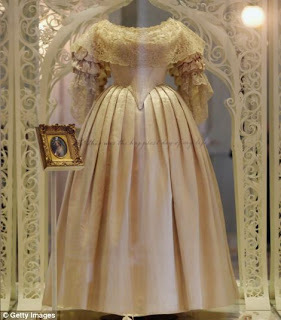 Queen Victoria's Wedding Gown, Kensington Palace
Queen Victoria's Wedding Gown, Kensington Palace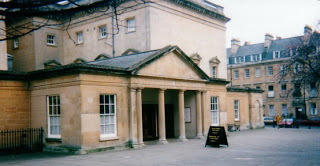 The Assembly Rooms, Bath
The Assembly Rooms, BathIn Bath, The Fashion Museum is located in the Assembly Rooms, which are administered by the National Trust. The Fashion Museum has more than 30,000 items from1600 to the present. The website is here.
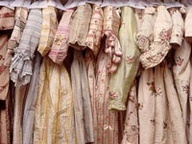 a view of storage at the Fashion Museum
a view of storage at the Fashion Museum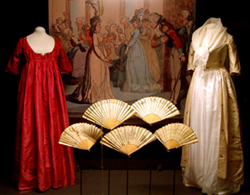 display at the Fashion Museum
display at the Fashion Museum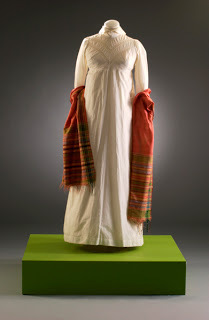 Gown of plain-weave white cotton, ca. 1813, with striped wool shawl Bath Fashion Museum
Gown of plain-weave white cotton, ca. 1813, with striped wool shawl Bath Fashion Museum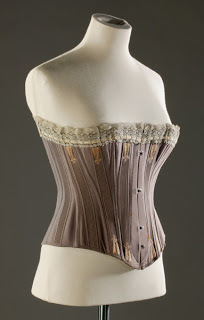 Lilac cotton sateen corset lined with cream cotton1880-85, Bath Fashion Museum
Lilac cotton sateen corset lined with cream cotton1880-85, Bath Fashion Museum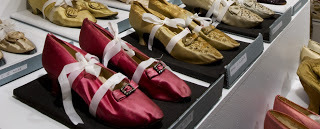 Shoes of many eras carefully preserved, Bath Fashion Museum
Shoes of many eras carefully preserved, Bath Fashion MuseumAnother excellent Fashion Museum shows many items owned and preserved the the National Trust at Killerton House, a Regency-era country villa in Devon. The website is here.
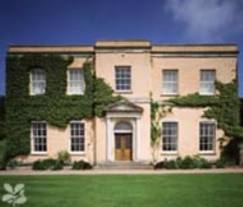 Killerton, NT
Killerton, NT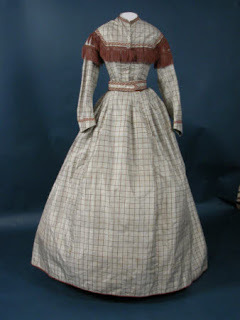 Croquet Dress, 1863-65, silk taffeta with glass buttonsKillerton House Fashion Collection
Croquet Dress, 1863-65, silk taffeta with glass buttonsKillerton House Fashion Collection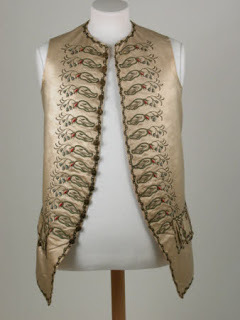 Man's Waistcoat, 1750, silk, satin, metalKillerton House Fashion Collection
Man's Waistcoat, 1750, silk, satin, metalKillerton House Fashion CollectionAlso at Killerton are many attractive rooms and an extensive garden to explore. As always, NT has a selection of tasty delights at the tea-room not to mention the temptations of the NT gift shop.
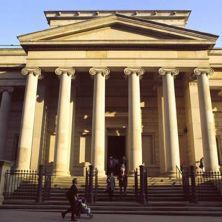 Manchester City Galleries
Manchester City GalleriesI have never visited Manchester (something I need to remedy), but the Manchester City Galleries website (here) has an extensive on-line fashion collection. Here are a couple of examples of their holdings.
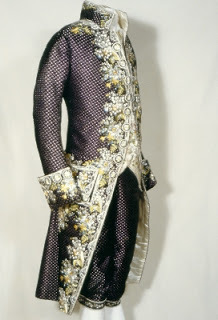 Man's Court Suit, 1775-85
Man's Court Suit, 1775-85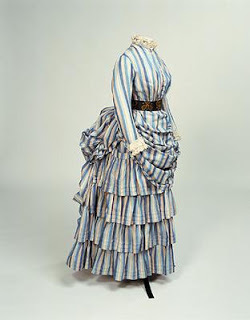 Tennis Dress, 1880's
Tennis Dress, 1880's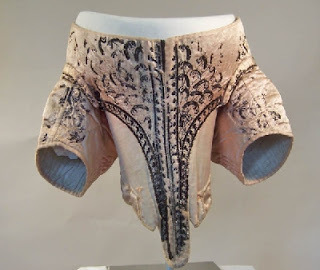 Bodice, 1650-1660, Dorset, UK
Bodice, 1650-1660, Dorset, UKFor a list of museums with fashion and costume collections, click here. And if you are a resident of the US, there are many outstanding fashion collections here too. Do you have any recommendations for good fashion collections on either side of the pond?
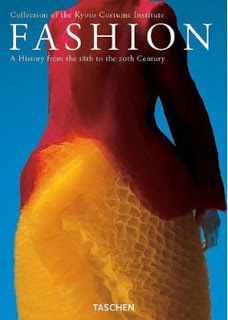
The Kyoto Fashion Institute seems to be an amazing place, or at least its website and publications are excellent. They organize many exhibitions, some of which are shown in venues outside Japan. Click here.
Published on July 27, 2012 01:00
July 25, 2012
The Sculptor Chantrey
For those of us who love to poke around in British palaces, castles, stately homes, museums and all sorts of historical sites (that's probably all of us), with a special interest in the Georgian and Victorian periods (most of us??), sooner or later we will begin to notice the recurring name of Francis Chantrey, a sculptor whose works are simply all over the place.
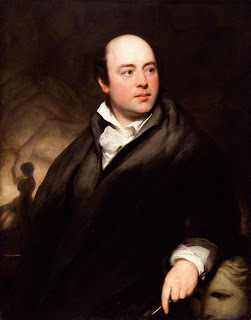 Sir Francis Legatt Chantrey, by Thomas Phillips, 1818 (NPG)
Sir Francis Legatt Chantrey, by Thomas Phillips, 1818 (NPG)
Sir Francis Legatt Chantrey (1781-1841) was not only a renowned and prolific artist, but also a philanthropist who left a bequest for the purchase of artwork for the nation. The income from investing the £105,000 from his legacy has been used to purchase hundreds of artworks by British artists for the nation's museums and continues to this day.
[image error] Chantrey self portrait, 1810, Tate Britain
The UK's National Portrait Gallery has hundreds of works by Chantrey himself, from sketches executed as preparation for his sculptures, to marble busts of leading men of his generation.
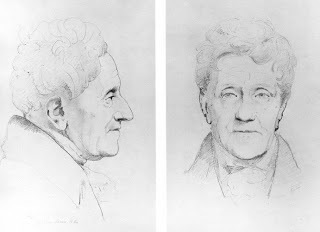
Drawings Chantrey made of Sir John Soane, preparatory work for the bust Chantrey sculpted which today can be seen in Sir John Soane's Museum, Lincoln's Inn Fields, London, below.
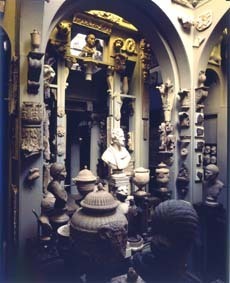
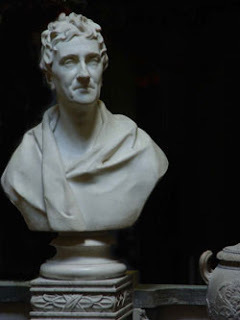 Close-up of the bust of Sir John Soane
Close-up of the bust of Sir John Soane
Last year, at the Yale Center for British Art, Diane Gaston, a well-known Regency author, and Victoria posed with a Chantrey bust of George IV.
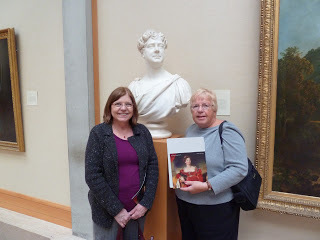
As so often in Georgian-era portraits, the subject is wearing a Roman-style toga. And without being unrealistic, somehow the expression on the King's face seems to me quite representative of his character. Unlike the overly flattering pictures by others, particularly Sir Thomas Lawrence, this Chantrey bust gives us a hint of the dichotomy in George IV: one the one hand selfish, narcissistic and extravagant -- but on the other hand, a great builder and connoisseur of the arts.
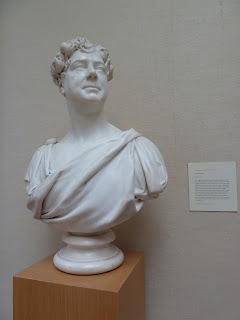 This Chantrey bust is one of several similar versions he and his studio produced, dated 1827.
This Chantrey bust is one of several similar versions he and his studio produced, dated 1827.
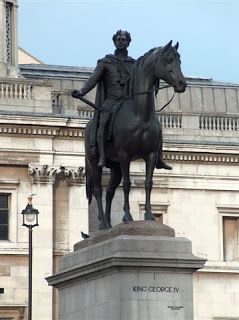 Chantrey's equestrian statue of George IV
Chantrey's equestrian statue of George IV
George IV and the royal family were frequent patrons of Chantrey. His bronze state of Geogbe IV on horseback can be found in Trafalgar Square, as above. Below is George IV in the center of the Grand Vestibule of Windsor Castle's State Rooms, flanked by mounted knights.
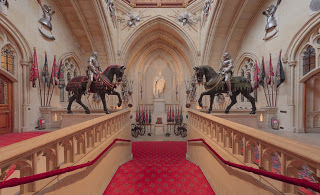
The magnificent statue of the mounted Duke of Wellington by Chantrey stands outside the Royal Exchange in the City of London.
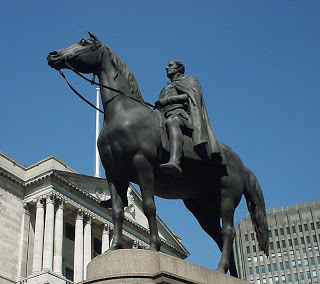
Below, a sketch of the pedestal made by Chantrey for the Wellington statue.
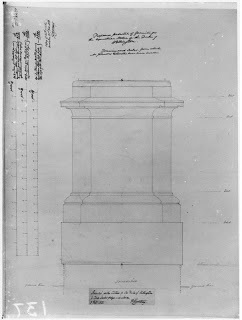
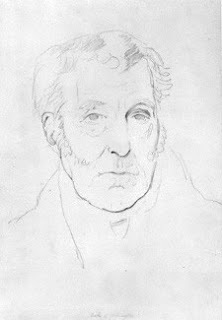 Chantrey's sketch of the Duke of Wellington for a bust.
Chantrey's sketch of the Duke of Wellington for a bust.
Born near Sheffield, Francis Chantrey was the son of a carpenter and became an apprentice to a woodcarver. His skill and talentset him apart, and he was given lessons in painting. He was a able to earn enough as a portrait painter to move to London, where by 1804, he was included in exhibitions at the Royal Academy
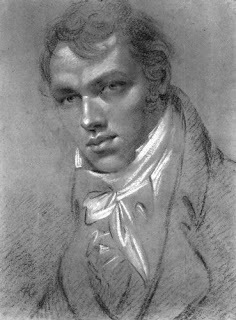 Chantrey Self-Portrait, NPG
Chantrey Self-Portrait, NPG
In a few years, he devoted himself mainly to sculpture. He married in 1807, and soon was doing commissions for naval officers and the Greenwich Hospital. He visited Italy in 1819 and associated with the leading artists of his day. He was knighted in 1835 by William IV. When he died, he was buried in a tomb he had constructed for himself in St. James Church, near Sheffield.
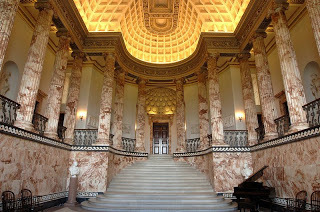 Above, the Marble Hall at Holkham Hall in Norfolk, the estate of the earls of Leicester. On either side of the staircase (on the right behind the piano) are two busts by Sir Francis Legatt Chantrey.
Above, the Marble Hall at Holkham Hall in Norfolk, the estate of the earls of Leicester. On either side of the staircase (on the right behind the piano) are two busts by Sir Francis Legatt Chantrey.
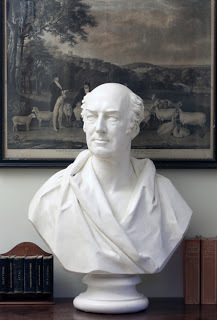 Reproduction of a marble bust of Coke of Norfolk (1754-1842), by Chantrey, from 1829, which can be purchased from the estate at their website: http://www.holkhamsculpturereproductions.co.uk/
Reproduction of a marble bust of Coke of Norfolk (1754-1842), by Chantrey, from 1829, which can be purchased from the estate at their website: http://www.holkhamsculpturereproductions.co.uk/
Coke of Norfolk, a great agricultural innovator, was the great nephew of Thomas Coke, and Coke of Norfolk was named 1st Earl of Leicester of the Seventh Creation in 1837.
Below, the reproduction of Chantrey's marble copy of a bust of Thomas Coke, first Earl of Leicester (1697-1759) of the Sixth Creation. created by Louis Francoise Roubilliac (1705-1762). Both busts were sculpted to stand among the large collection of classical busts acquired by Thomas Coke and displayed at Holkham.
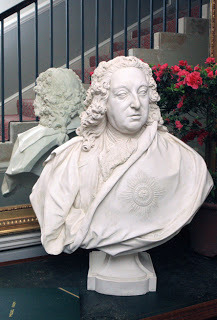
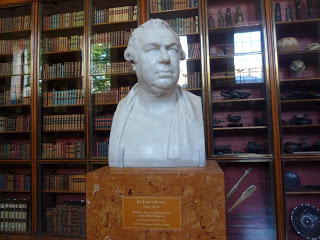 Above, Sir Joseph Banks in the British Museum, Botanist, Trustee and Benefactor, by Sir Francis Chantey, dated 1826.
Above, Sir Joseph Banks in the British Museum, Botanist, Trustee and Benefactor, by Sir Francis Chantey, dated 1826.
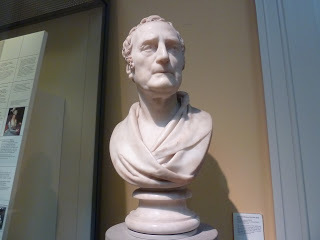 Also displayed in the British Museum, Chantrey's bust of his collaborator and mentor, the famous 18th c. sculptor Joseph Nollekens (1737-1823).
Also displayed in the British Museum, Chantrey's bust of his collaborator and mentor, the famous 18th c. sculptor Joseph Nollekens (1737-1823).
Besides the dozens of busts Chantrey sculpted, which were highly prized and sought after, he did some touching works which displayed his skill in composition as well as compassion.
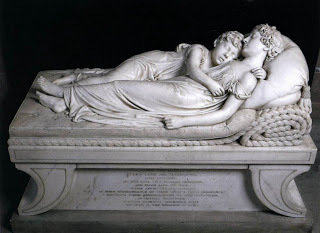
The Sleeping Children, 1817, above, in the Litchfield Cathedral, was commissioned by the widowed mother of the two dead girls, Mrs. Ellen-Jane Woodhouse Robinson. Most observers find it the finest of Chantrey's works.
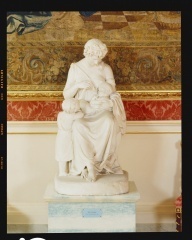 The Royal Collection
The Royal Collection
The lovely portrayal of Dorothea Jordan was commissioned from Chantrey by King William IV and completed in 1834. It has been displayed in Buckingham Palace since 1980. Mrs. Jordan, a leading actress of her day, was the long-time mistress of William IV when he was Duke of Clarence and bore him ten children, known by the surname FitzClarence.
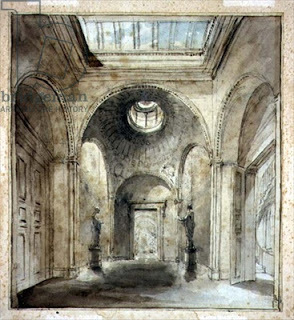 Bridgeman
Bridgeman
This drawing of the anteroom of Chantrey's sculpture gallery (30 Belgrave Place) shows its design by Sir John Soane for his friend, the sculptor.
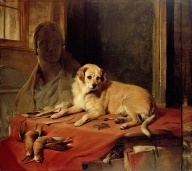 Pen, Brush and Chisel: The Studio of Sir Francis Chantrey by artist Sir Edwin Landseer (1803-73), Royal Collection
Pen, Brush and Chisel: The Studio of Sir Francis Chantrey by artist Sir Edwin Landseer (1803-73), Royal Collection
This charming portrait of Mustard, Chantrey's terrier, and his sculpting tools was presented to Queen Victoria by Lady Chantrey in 1842. According to the description in the Royal Collection, "The painting was commissioned in April 1835 by Chantrey, who sent Landseer a humorous letter, supposedly from Mustard. It was exhibited at the Royal Academy in 1836 when it was admired by Queen Victoria." After Chantrey's death, his widow presented the painting to the Queen.
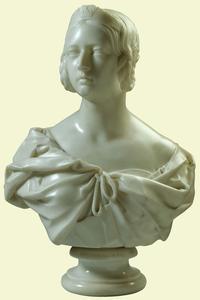 Queen Victoria, marble, 1841, by Sir Francis Chantrey, Royal Collection
Queen Victoria, marble, 1841, by Sir Francis Chantrey, Royal Collection
Chantrey created portraits of four British sovereigns. Above, his last work, a bust of Queen Victoria, was Prince Albert's favorite portrayal of his wife
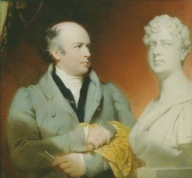
Also in the Royal Collection is this watercolour on ivory by Andrew Robertson (1777-1845), dated 1800. Purchased by Queen Victoria in 1880, it portrays Chantrey "Half-length, standing, facing slightly to the right, wearing a grey studio coat and dark blue waistcoat and holding a hammer, chisel and yellow dustcloth, beside his bust of George IV; grey-blue eyes, grey-brown hair; red curtains background."
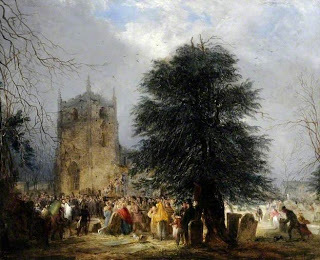
The painting above is The Burial of Sir Frances Chantrey by artist Henry Perlee Parker, 1841. It was badly damaged in a flood in 2007 at the Weston Park Museum, Sheffield, and had to be dried for more than a year before it was conserved. Chantrey is buried in St. James Church, Sheffield, near the village of his birth.
 Sir Francis Legatt Chantrey, by Thomas Phillips, 1818 (NPG)
Sir Francis Legatt Chantrey, by Thomas Phillips, 1818 (NPG)Sir Francis Legatt Chantrey (1781-1841) was not only a renowned and prolific artist, but also a philanthropist who left a bequest for the purchase of artwork for the nation. The income from investing the £105,000 from his legacy has been used to purchase hundreds of artworks by British artists for the nation's museums and continues to this day.
[image error] Chantrey self portrait, 1810, Tate Britain
The UK's National Portrait Gallery has hundreds of works by Chantrey himself, from sketches executed as preparation for his sculptures, to marble busts of leading men of his generation.

Drawings Chantrey made of Sir John Soane, preparatory work for the bust Chantrey sculpted which today can be seen in Sir John Soane's Museum, Lincoln's Inn Fields, London, below.

 Close-up of the bust of Sir John Soane
Close-up of the bust of Sir John SoaneLast year, at the Yale Center for British Art, Diane Gaston, a well-known Regency author, and Victoria posed with a Chantrey bust of George IV.

As so often in Georgian-era portraits, the subject is wearing a Roman-style toga. And without being unrealistic, somehow the expression on the King's face seems to me quite representative of his character. Unlike the overly flattering pictures by others, particularly Sir Thomas Lawrence, this Chantrey bust gives us a hint of the dichotomy in George IV: one the one hand selfish, narcissistic and extravagant -- but on the other hand, a great builder and connoisseur of the arts.
 This Chantrey bust is one of several similar versions he and his studio produced, dated 1827.
This Chantrey bust is one of several similar versions he and his studio produced, dated 1827. Chantrey's equestrian statue of George IV
Chantrey's equestrian statue of George IV George IV and the royal family were frequent patrons of Chantrey. His bronze state of Geogbe IV on horseback can be found in Trafalgar Square, as above. Below is George IV in the center of the Grand Vestibule of Windsor Castle's State Rooms, flanked by mounted knights.

The magnificent statue of the mounted Duke of Wellington by Chantrey stands outside the Royal Exchange in the City of London.

Below, a sketch of the pedestal made by Chantrey for the Wellington statue.

 Chantrey's sketch of the Duke of Wellington for a bust.
Chantrey's sketch of the Duke of Wellington for a bust.Born near Sheffield, Francis Chantrey was the son of a carpenter and became an apprentice to a woodcarver. His skill and talentset him apart, and he was given lessons in painting. He was a able to earn enough as a portrait painter to move to London, where by 1804, he was included in exhibitions at the Royal Academy
 Chantrey Self-Portrait, NPG
Chantrey Self-Portrait, NPGIn a few years, he devoted himself mainly to sculpture. He married in 1807, and soon was doing commissions for naval officers and the Greenwich Hospital. He visited Italy in 1819 and associated with the leading artists of his day. He was knighted in 1835 by William IV. When he died, he was buried in a tomb he had constructed for himself in St. James Church, near Sheffield.
 Above, the Marble Hall at Holkham Hall in Norfolk, the estate of the earls of Leicester. On either side of the staircase (on the right behind the piano) are two busts by Sir Francis Legatt Chantrey.
Above, the Marble Hall at Holkham Hall in Norfolk, the estate of the earls of Leicester. On either side of the staircase (on the right behind the piano) are two busts by Sir Francis Legatt Chantrey. Reproduction of a marble bust of Coke of Norfolk (1754-1842), by Chantrey, from 1829, which can be purchased from the estate at their website: http://www.holkhamsculpturereproductions.co.uk/
Reproduction of a marble bust of Coke of Norfolk (1754-1842), by Chantrey, from 1829, which can be purchased from the estate at their website: http://www.holkhamsculpturereproductions.co.uk/Coke of Norfolk, a great agricultural innovator, was the great nephew of Thomas Coke, and Coke of Norfolk was named 1st Earl of Leicester of the Seventh Creation in 1837.
Below, the reproduction of Chantrey's marble copy of a bust of Thomas Coke, first Earl of Leicester (1697-1759) of the Sixth Creation. created by Louis Francoise Roubilliac (1705-1762). Both busts were sculpted to stand among the large collection of classical busts acquired by Thomas Coke and displayed at Holkham.

 Above, Sir Joseph Banks in the British Museum, Botanist, Trustee and Benefactor, by Sir Francis Chantey, dated 1826.
Above, Sir Joseph Banks in the British Museum, Botanist, Trustee and Benefactor, by Sir Francis Chantey, dated 1826. Also displayed in the British Museum, Chantrey's bust of his collaborator and mentor, the famous 18th c. sculptor Joseph Nollekens (1737-1823).
Also displayed in the British Museum, Chantrey's bust of his collaborator and mentor, the famous 18th c. sculptor Joseph Nollekens (1737-1823). Besides the dozens of busts Chantrey sculpted, which were highly prized and sought after, he did some touching works which displayed his skill in composition as well as compassion.

The Sleeping Children, 1817, above, in the Litchfield Cathedral, was commissioned by the widowed mother of the two dead girls, Mrs. Ellen-Jane Woodhouse Robinson. Most observers find it the finest of Chantrey's works.
 The Royal Collection
The Royal CollectionThe lovely portrayal of Dorothea Jordan was commissioned from Chantrey by King William IV and completed in 1834. It has been displayed in Buckingham Palace since 1980. Mrs. Jordan, a leading actress of her day, was the long-time mistress of William IV when he was Duke of Clarence and bore him ten children, known by the surname FitzClarence.
 Bridgeman
BridgemanThis drawing of the anteroom of Chantrey's sculpture gallery (30 Belgrave Place) shows its design by Sir John Soane for his friend, the sculptor.
 Pen, Brush and Chisel: The Studio of Sir Francis Chantrey by artist Sir Edwin Landseer (1803-73), Royal Collection
Pen, Brush and Chisel: The Studio of Sir Francis Chantrey by artist Sir Edwin Landseer (1803-73), Royal CollectionThis charming portrait of Mustard, Chantrey's terrier, and his sculpting tools was presented to Queen Victoria by Lady Chantrey in 1842. According to the description in the Royal Collection, "The painting was commissioned in April 1835 by Chantrey, who sent Landseer a humorous letter, supposedly from Mustard. It was exhibited at the Royal Academy in 1836 when it was admired by Queen Victoria." After Chantrey's death, his widow presented the painting to the Queen.
 Queen Victoria, marble, 1841, by Sir Francis Chantrey, Royal Collection
Queen Victoria, marble, 1841, by Sir Francis Chantrey, Royal CollectionChantrey created portraits of four British sovereigns. Above, his last work, a bust of Queen Victoria, was Prince Albert's favorite portrayal of his wife

Also in the Royal Collection is this watercolour on ivory by Andrew Robertson (1777-1845), dated 1800. Purchased by Queen Victoria in 1880, it portrays Chantrey "Half-length, standing, facing slightly to the right, wearing a grey studio coat and dark blue waistcoat and holding a hammer, chisel and yellow dustcloth, beside his bust of George IV; grey-blue eyes, grey-brown hair; red curtains background."

The painting above is The Burial of Sir Frances Chantrey by artist Henry Perlee Parker, 1841. It was badly damaged in a flood in 2007 at the Weston Park Museum, Sheffield, and had to be dried for more than a year before it was conserved. Chantrey is buried in St. James Church, Sheffield, near the village of his birth.
Published on July 25, 2012 00:32
July 23, 2012
The Court Journal for July 1835
From
Gazette of the Fashionable World July 1835
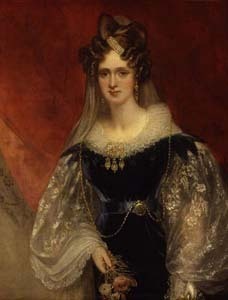
COURT AND FASHIONABLE LIFE.— Their Majesties will come to town on Tuesday, and remain till Saturday, during which time two grand dinners will be given at the Palace. The King will hold an investiture of the Most Illustrious Order of St Patrick on Tuesday, at which the Earl of Howth will be appointed a Knight Commander of the Order. On Thursday his Majesty will inspect the Artillery at Woolwich.— The King and Queen will give a grand entertainment at St James's Palace on Saturday next, in honour of the birth-day of the amiable Duchess of Cambridge. All the Royal Family, the foreign Ambassadors and their Ladies, his Majesty's Ministers, the usual Court Circle, and a select number of the Nobility, are invited to the banquet.— The Duke of Cumberland honoured Viscount Canterbury with his company at dinner on Thursday evening. The Marquess Camden, Marquess of Hertford, Lords Lyndhurst, Hill, Fitzgerald, and Lieven, and a select party, were present to meet his Royal Highness.— The Duke of Cumberland will shortly take his departure for the continent, to represent his Majesty at the coronation of the Emperor of Austria at Prague. The Royal Duke, after the coronation, will remain on the continent with the Duchess and Prince George until next year.— Sir Charles and Lady Ogle are preparing to take their departure for the Continent, where they will remain till the commencement of the next season.— Lord Elphinstone, one of his Majesty's Lords in Waiting, has been despatched to the Hague for the purpose of inviting his Majesty, the King of Wirtemburg, who, with his daughters, the Princesses Mary and Sophia, are at present staying on a visit to the King and Queen of Holland. His Majesty was last on a visit to the Royal Family here in 1830.
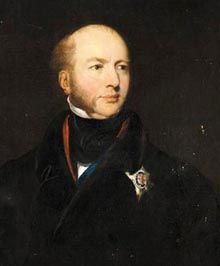
The Marquess of Hertford (above) will give another splendid entertainment on Saturday next, at his beautiful villa, in the Regent's Park, to which more than five hundred distinguished persons are invited. It is said the noble marquess and his extensive suite will leave this country for Italy, soon after the prorogation of Parliament. — The King of Prussia has had medals struck in gold in honour of the late Emperor of Austria, which are intended for presents to diplomatists known to be favourable to the policy of the deceased Monarch. Copies in bronze are likewise to be taken, which are to be distributed among the soldiery.— The Earl of Mulgrave is about to proceed on a tour through Ireland. The Countess, during his Lordship's absence, will pay a visit to Lord and Lady Ravensworth, in London.— The Duke of Somerset and the Lady St Maur gave a dejeuner on Monday, at Wimbledon Park, which was graced by nearly all the persons of high rank and fashion now in the metropolis. It was a brilliant day, and a late hour in the evening before the company departed.
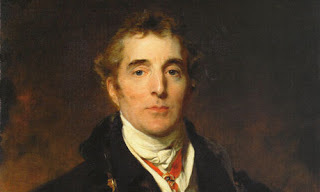
— The Marquess and Marchioness of Salisbury will give a grand entertainment at Hatfield House, next Saturday, to which the Duke of Wellington (above) and a large portion of the fashionable world are invited. The splendid palace, which has for some time been under a state of repair, is now finished. The interior has been newly decorated, and furnished in a style of magnificence peculiar to the refined taste of the noble owner. —The Duchess of St Albans lost a valuable ruby set with diamonds, at the Colosseum fete on Thursday week. It was picked up by a gentleman, and returned to her Grace a day or two afterwards.— We understand that the inhabitants of Hammersmith have had a public meeting, at which they determined to testify their loyalty by erecting a triumphal arch across the road on Thursday next, when their Majesties visit the Earl and Countess of Mansfield, at Caen Wood. The arch is to be sixty feet high by forty feet in width; and the various lodges and societies of the neighbourhood are to be drawn up on either side of the road with their bands of music.— The marriage of Prince Leopold of Naples with Princess Maria of Orleans is now finally decided upon. The President and Grand Referendary of the Chamber of Peers are drawing up the articles, and the nuptials, which the King and Queen of the Belgians are to attend, are to take place at the Chateau d'Eu, in Normandy.The Opening Banquet at Goldsmith's Hall.—In order to do honour to the new Hall, a select party was invited to the opening dinner, which took place on Wednesday evening under very distinguished auspices. The Duke of Wellington, Sir Robert Peel, the Marquess Camden, Earl of Darlington, Lord Maryborough, Lord Abinger, the Vice-Chancellor, Lord Bexley, Sir Henry Hardinge, Sir Edward Cust, and many other persons of rank were present. The Duke of Wellington went in his state carriage, and was greeted with the hearty cheers of the crowd assembled to witness the company alight. Sir Robert Peel was received with a similar demonstration of popularity. The best arrangements were made for the reception of the guests, who amounted to about 250. The dinner took place in the Livery Hall, about seven o'clock, when the company sat down to a sumptuous repast, con sisting of all the luxuries and delicacies of the season. The band of the Coldstream Guards was stationed in the Marble Gallery. The chandeliers in the Livery Hall, especially the great one in the centre for seventy-two wax-lights, are perhaps as fine specimens of that manufacture as can be seen in or out of England. The branching arms, large and variegated centre shafts, exhibit nothing but glass, cither richly cut, or in masses of brilliant drops, long prisms, the whole when lighted producing a most dazzling effect. These, with the lustres in the Court rooms, as well as the great metal lamp chandelier, suspended from the dome over the grand staircase, were, we understand, supplied by Perry and Co., of Bond street.
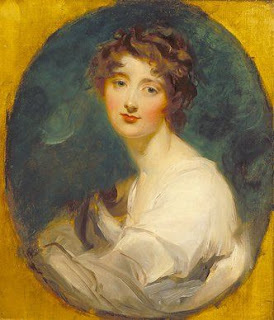 — The Duchess of St. Albans (above) gave another Dejeuner Fete, at Holly Lodge, on Saturday last. The house and grounds were decorated with choice flowering plants, the balconies filled with pink hydrangeas and white lilies, the long walk and the lawn before the house had orange trees full of fruit, and round the door and the music tent were stands of splendid flowers. Three large temporary rooms were erected, hung with pink and white, the draperies wreathed with roses, and at the end large looking-glasses were placed, which increased the appearance of the gay scene. The entertainments commenced with a concert, conducted by Sir G. Smart and Signor Gahussi, in which Grisi, Malihran, Stockhausen, Lablache, Tans burini, Rubini, Mr and Mrs Bishop, Mr and Mrs Knyvett Philips performed. During the intervals between the singing, the Coldstream band played in the grounds. About six o'clock the guests sat down to the banquet, after which they went to the hill, where the Grand Falconer exhibited a flight of hawks. Dancing then commenced in the tent and ball-room, continuing until near midnight, except during the interval occupied by the fireworks, which were exceedingly splendid.— Lady Willoughby D'Eresby gave a grand ball last evening at her mansion in Piccadilly, which was so numerously attended, that for some time the street was rendered nearly impassable, although the ingress and egress were admirably regulated by the police.— The third grand ball given on Thursday by the Officers at Woolwich, was attended by all the beauty and fashion in that neighbourhood, and a number of lovely women and distinguished persons from the metropolis.— Burleigh House, near Stamford, the magnificent seat of the Marquess of Exeter, on Tuesday last presented one continued scene of gaiety and old English hospitality, worthy the descendant of the great Lord Burleigh. All the Nobility and Gentry in that richly populated neighbourhood were invited, and many distinguished guests from London joined the enchanting scene of festivity and splendour.— Lord Stanley is at Knowsley Hall, in Lancashire, the seat of his father, the Earl of Derby. His Lordship will return to his duties in Parliament immediately after Liverpool races, where several horses from the stud of Lord Derby are engaged to run.— The Duchess of Saxe-Weimar and family arrived at Deptford on Sunday from Rotterdam. Her Serene Highness was received by the Earl of Denbigh and Mr Hudson, and immediately entered one of the Royal carriages, followed by her suite in a second carriage and four. Near New Cross the Duchess was met by the Queen, and accompanied her Majesty to St James's.
— The Duchess of St. Albans (above) gave another Dejeuner Fete, at Holly Lodge, on Saturday last. The house and grounds were decorated with choice flowering plants, the balconies filled with pink hydrangeas and white lilies, the long walk and the lawn before the house had orange trees full of fruit, and round the door and the music tent were stands of splendid flowers. Three large temporary rooms were erected, hung with pink and white, the draperies wreathed with roses, and at the end large looking-glasses were placed, which increased the appearance of the gay scene. The entertainments commenced with a concert, conducted by Sir G. Smart and Signor Gahussi, in which Grisi, Malihran, Stockhausen, Lablache, Tans burini, Rubini, Mr and Mrs Bishop, Mr and Mrs Knyvett Philips performed. During the intervals between the singing, the Coldstream band played in the grounds. About six o'clock the guests sat down to the banquet, after which they went to the hill, where the Grand Falconer exhibited a flight of hawks. Dancing then commenced in the tent and ball-room, continuing until near midnight, except during the interval occupied by the fireworks, which were exceedingly splendid.— Lady Willoughby D'Eresby gave a grand ball last evening at her mansion in Piccadilly, which was so numerously attended, that for some time the street was rendered nearly impassable, although the ingress and egress were admirably regulated by the police.— The third grand ball given on Thursday by the Officers at Woolwich, was attended by all the beauty and fashion in that neighbourhood, and a number of lovely women and distinguished persons from the metropolis.— Burleigh House, near Stamford, the magnificent seat of the Marquess of Exeter, on Tuesday last presented one continued scene of gaiety and old English hospitality, worthy the descendant of the great Lord Burleigh. All the Nobility and Gentry in that richly populated neighbourhood were invited, and many distinguished guests from London joined the enchanting scene of festivity and splendour.— Lord Stanley is at Knowsley Hall, in Lancashire, the seat of his father, the Earl of Derby. His Lordship will return to his duties in Parliament immediately after Liverpool races, where several horses from the stud of Lord Derby are engaged to run.— The Duchess of Saxe-Weimar and family arrived at Deptford on Sunday from Rotterdam. Her Serene Highness was received by the Earl of Denbigh and Mr Hudson, and immediately entered one of the Royal carriages, followed by her suite in a second carriage and four. Near New Cross the Duchess was met by the Queen, and accompanied her Majesty to St James's.
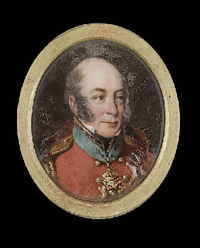
— On the evening of Tuesday week, while the Duchess of Cambridge was quitting the French Theatre, Sir James Reynett (above), who was handing her Royal Highness to her carriage, was robbed of a valuable gold snuff-box.— The accomplished Duchess of Sutherland gave a grand assembly on Wednesday, at Sutherland House, in the Green Park. The mansion presented, in the interior, one continued blaze of light, which reflected splendor on the magnificent collection of pictures displayed in the rooms of that noble building.
Gazette of the Fashionable World July 1835

COURT AND FASHIONABLE LIFE.— Their Majesties will come to town on Tuesday, and remain till Saturday, during which time two grand dinners will be given at the Palace. The King will hold an investiture of the Most Illustrious Order of St Patrick on Tuesday, at which the Earl of Howth will be appointed a Knight Commander of the Order. On Thursday his Majesty will inspect the Artillery at Woolwich.— The King and Queen will give a grand entertainment at St James's Palace on Saturday next, in honour of the birth-day of the amiable Duchess of Cambridge. All the Royal Family, the foreign Ambassadors and their Ladies, his Majesty's Ministers, the usual Court Circle, and a select number of the Nobility, are invited to the banquet.— The Duke of Cumberland honoured Viscount Canterbury with his company at dinner on Thursday evening. The Marquess Camden, Marquess of Hertford, Lords Lyndhurst, Hill, Fitzgerald, and Lieven, and a select party, were present to meet his Royal Highness.— The Duke of Cumberland will shortly take his departure for the continent, to represent his Majesty at the coronation of the Emperor of Austria at Prague. The Royal Duke, after the coronation, will remain on the continent with the Duchess and Prince George until next year.— Sir Charles and Lady Ogle are preparing to take their departure for the Continent, where they will remain till the commencement of the next season.— Lord Elphinstone, one of his Majesty's Lords in Waiting, has been despatched to the Hague for the purpose of inviting his Majesty, the King of Wirtemburg, who, with his daughters, the Princesses Mary and Sophia, are at present staying on a visit to the King and Queen of Holland. His Majesty was last on a visit to the Royal Family here in 1830.

The Marquess of Hertford (above) will give another splendid entertainment on Saturday next, at his beautiful villa, in the Regent's Park, to which more than five hundred distinguished persons are invited. It is said the noble marquess and his extensive suite will leave this country for Italy, soon after the prorogation of Parliament. — The King of Prussia has had medals struck in gold in honour of the late Emperor of Austria, which are intended for presents to diplomatists known to be favourable to the policy of the deceased Monarch. Copies in bronze are likewise to be taken, which are to be distributed among the soldiery.— The Earl of Mulgrave is about to proceed on a tour through Ireland. The Countess, during his Lordship's absence, will pay a visit to Lord and Lady Ravensworth, in London.— The Duke of Somerset and the Lady St Maur gave a dejeuner on Monday, at Wimbledon Park, which was graced by nearly all the persons of high rank and fashion now in the metropolis. It was a brilliant day, and a late hour in the evening before the company departed.

— The Marquess and Marchioness of Salisbury will give a grand entertainment at Hatfield House, next Saturday, to which the Duke of Wellington (above) and a large portion of the fashionable world are invited. The splendid palace, which has for some time been under a state of repair, is now finished. The interior has been newly decorated, and furnished in a style of magnificence peculiar to the refined taste of the noble owner. —The Duchess of St Albans lost a valuable ruby set with diamonds, at the Colosseum fete on Thursday week. It was picked up by a gentleman, and returned to her Grace a day or two afterwards.— We understand that the inhabitants of Hammersmith have had a public meeting, at which they determined to testify their loyalty by erecting a triumphal arch across the road on Thursday next, when their Majesties visit the Earl and Countess of Mansfield, at Caen Wood. The arch is to be sixty feet high by forty feet in width; and the various lodges and societies of the neighbourhood are to be drawn up on either side of the road with their bands of music.— The marriage of Prince Leopold of Naples with Princess Maria of Orleans is now finally decided upon. The President and Grand Referendary of the Chamber of Peers are drawing up the articles, and the nuptials, which the King and Queen of the Belgians are to attend, are to take place at the Chateau d'Eu, in Normandy.The Opening Banquet at Goldsmith's Hall.—In order to do honour to the new Hall, a select party was invited to the opening dinner, which took place on Wednesday evening under very distinguished auspices. The Duke of Wellington, Sir Robert Peel, the Marquess Camden, Earl of Darlington, Lord Maryborough, Lord Abinger, the Vice-Chancellor, Lord Bexley, Sir Henry Hardinge, Sir Edward Cust, and many other persons of rank were present. The Duke of Wellington went in his state carriage, and was greeted with the hearty cheers of the crowd assembled to witness the company alight. Sir Robert Peel was received with a similar demonstration of popularity. The best arrangements were made for the reception of the guests, who amounted to about 250. The dinner took place in the Livery Hall, about seven o'clock, when the company sat down to a sumptuous repast, con sisting of all the luxuries and delicacies of the season. The band of the Coldstream Guards was stationed in the Marble Gallery. The chandeliers in the Livery Hall, especially the great one in the centre for seventy-two wax-lights, are perhaps as fine specimens of that manufacture as can be seen in or out of England. The branching arms, large and variegated centre shafts, exhibit nothing but glass, cither richly cut, or in masses of brilliant drops, long prisms, the whole when lighted producing a most dazzling effect. These, with the lustres in the Court rooms, as well as the great metal lamp chandelier, suspended from the dome over the grand staircase, were, we understand, supplied by Perry and Co., of Bond street.
 — The Duchess of St. Albans (above) gave another Dejeuner Fete, at Holly Lodge, on Saturday last. The house and grounds were decorated with choice flowering plants, the balconies filled with pink hydrangeas and white lilies, the long walk and the lawn before the house had orange trees full of fruit, and round the door and the music tent were stands of splendid flowers. Three large temporary rooms were erected, hung with pink and white, the draperies wreathed with roses, and at the end large looking-glasses were placed, which increased the appearance of the gay scene. The entertainments commenced with a concert, conducted by Sir G. Smart and Signor Gahussi, in which Grisi, Malihran, Stockhausen, Lablache, Tans burini, Rubini, Mr and Mrs Bishop, Mr and Mrs Knyvett Philips performed. During the intervals between the singing, the Coldstream band played in the grounds. About six o'clock the guests sat down to the banquet, after which they went to the hill, where the Grand Falconer exhibited a flight of hawks. Dancing then commenced in the tent and ball-room, continuing until near midnight, except during the interval occupied by the fireworks, which were exceedingly splendid.— Lady Willoughby D'Eresby gave a grand ball last evening at her mansion in Piccadilly, which was so numerously attended, that for some time the street was rendered nearly impassable, although the ingress and egress were admirably regulated by the police.— The third grand ball given on Thursday by the Officers at Woolwich, was attended by all the beauty and fashion in that neighbourhood, and a number of lovely women and distinguished persons from the metropolis.— Burleigh House, near Stamford, the magnificent seat of the Marquess of Exeter, on Tuesday last presented one continued scene of gaiety and old English hospitality, worthy the descendant of the great Lord Burleigh. All the Nobility and Gentry in that richly populated neighbourhood were invited, and many distinguished guests from London joined the enchanting scene of festivity and splendour.— Lord Stanley is at Knowsley Hall, in Lancashire, the seat of his father, the Earl of Derby. His Lordship will return to his duties in Parliament immediately after Liverpool races, where several horses from the stud of Lord Derby are engaged to run.— The Duchess of Saxe-Weimar and family arrived at Deptford on Sunday from Rotterdam. Her Serene Highness was received by the Earl of Denbigh and Mr Hudson, and immediately entered one of the Royal carriages, followed by her suite in a second carriage and four. Near New Cross the Duchess was met by the Queen, and accompanied her Majesty to St James's.
— The Duchess of St. Albans (above) gave another Dejeuner Fete, at Holly Lodge, on Saturday last. The house and grounds were decorated with choice flowering plants, the balconies filled with pink hydrangeas and white lilies, the long walk and the lawn before the house had orange trees full of fruit, and round the door and the music tent were stands of splendid flowers. Three large temporary rooms were erected, hung with pink and white, the draperies wreathed with roses, and at the end large looking-glasses were placed, which increased the appearance of the gay scene. The entertainments commenced with a concert, conducted by Sir G. Smart and Signor Gahussi, in which Grisi, Malihran, Stockhausen, Lablache, Tans burini, Rubini, Mr and Mrs Bishop, Mr and Mrs Knyvett Philips performed. During the intervals between the singing, the Coldstream band played in the grounds. About six o'clock the guests sat down to the banquet, after which they went to the hill, where the Grand Falconer exhibited a flight of hawks. Dancing then commenced in the tent and ball-room, continuing until near midnight, except during the interval occupied by the fireworks, which were exceedingly splendid.— Lady Willoughby D'Eresby gave a grand ball last evening at her mansion in Piccadilly, which was so numerously attended, that for some time the street was rendered nearly impassable, although the ingress and egress were admirably regulated by the police.— The third grand ball given on Thursday by the Officers at Woolwich, was attended by all the beauty and fashion in that neighbourhood, and a number of lovely women and distinguished persons from the metropolis.— Burleigh House, near Stamford, the magnificent seat of the Marquess of Exeter, on Tuesday last presented one continued scene of gaiety and old English hospitality, worthy the descendant of the great Lord Burleigh. All the Nobility and Gentry in that richly populated neighbourhood were invited, and many distinguished guests from London joined the enchanting scene of festivity and splendour.— Lord Stanley is at Knowsley Hall, in Lancashire, the seat of his father, the Earl of Derby. His Lordship will return to his duties in Parliament immediately after Liverpool races, where several horses from the stud of Lord Derby are engaged to run.— The Duchess of Saxe-Weimar and family arrived at Deptford on Sunday from Rotterdam. Her Serene Highness was received by the Earl of Denbigh and Mr Hudson, and immediately entered one of the Royal carriages, followed by her suite in a second carriage and four. Near New Cross the Duchess was met by the Queen, and accompanied her Majesty to St James's.
— On the evening of Tuesday week, while the Duchess of Cambridge was quitting the French Theatre, Sir James Reynett (above), who was handing her Royal Highness to her carriage, was robbed of a valuable gold snuff-box.— The accomplished Duchess of Sutherland gave a grand assembly on Wednesday, at Sutherland House, in the Green Park. The mansion presented, in the interior, one continued blaze of light, which reflected splendor on the magnificent collection of pictures displayed in the rooms of that noble building.
Published on July 23, 2012 00:31
July 21, 2012
The Wellington Connection: The Household Calvary
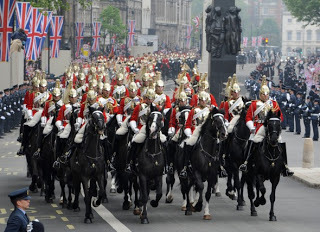
As we recently ran a post about a Household Calvary horse named Sefton, we thought it would be appropriate to look into the Duke of Wellington's connection to the Household Calvary, a term used to describe the cavalry of the Household Division, the most elite senior military groupings or those military groupings that provide functions associated directly with the Royal Family. The British Household Cavalry is made up of two regiments of the British armed forces, the Life Guards and the Blues and Royals (Royal Horse Guards and 1st Dragoons). These regiments are divided between the Armoured Regiment stationed at Combermere Barracks in Windsor and the Household Calvary stationed at Knightsbridge Barracks, London.
The first Regiment with whom the Duke of Wellington was connected was the Royal, or 1st, Dragoons, who served under Wellington, as Lord Wellesley, during the Peninsular War. They acted as rearguard during the retreat at the Torres Vedras lines in 1810 and their charge at Fuentes d'Onor in 1811 contributed greatly to that victory. By the end of 1814, the Royal Dragoons had advanced into southern France and were granted permission to march through France to Calais.
In 1815, their successful charge at Waterloo alongside the Union Brigade was responsible for maintaining the Allies' weakest position until the Prussians arrived. The famous charge against the French Cuirassiers took place at the height of the battle and saved the British centre from being overrun. During this charge, the 105 Eagle, now part of the The Royals' and The Blues dress, was captured from the French 105th Infantry Regiment of the Line by Captain Clarke and/or Corporal Stiles.
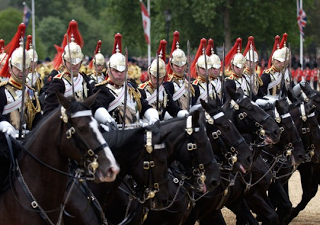
However, the Duke of Wellington is most closely connected to the Royal Horseguards, also called The Blues. He was appointed as Colonel of the Regiment on 1st January, 1813, which proved to be the first step towards raising The Blues to the distinction of belonging to the Household Calvary. Wellington was the first Colonel to take office as Gold Stick with the colonels of the 1st and 2nd Life Guards, regiments with whom The Blues fought at the battle of Vittoria.
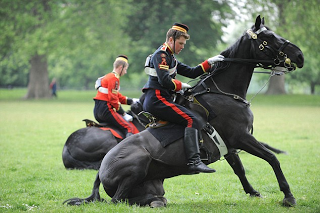 The Blues formed the Heavy Cavalary Brigade at Waterloo, fighting alongside the 1st and 2nd Regiments of Life Guards. At the beginning of the Brigade charge, the Regiment was in support, but as the charge unfolded, they drew into the first line. After the battle, the following equine casualties were reported: 48 killed, 21 wounded and 25 missing.
The Blues formed the Heavy Cavalary Brigade at Waterloo, fighting alongside the 1st and 2nd Regiments of Life Guards. At the beginning of the Brigade charge, the Regiment was in support, but as the charge unfolded, they drew into the first line. After the battle, the following equine casualties were reported: 48 killed, 21 wounded and 25 missing. In 1821, King George IV ordered the Regiment to be brigaded with the 1st and 2nd Life Guards and to share the duties of the King's Life Guard.
Today, the Household Cavalry continue to guard the monarch, appearing daily at the Changing of the Guard at Buckingham Palace. Fittingly, the Viewing Galleries within the Wellington Arch, in front of Apsley House, offer unique views of the Household Cavalry passing beneath the Arch on their way to and from the Changing of the Guard. The Arch opens daily at 10 a.m., with the Guards usually passing at around 10:30 a.m.
Published on July 21, 2012 00:28
July 19, 2012
The Story of Sefton
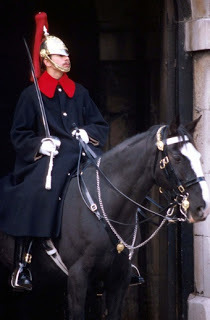
SEFTON served with the British Army for 17 years from 1967 to 1984, coming to prominence when he was critically injured in the Hyde Park and Regent's Park bombings of July 20, 1982. Eight soldiers on ceremonial duty were killed in two IRA bomb blasts. The first blast, in Hyde Park, killed two soldiers and injured 23 others and the second explosion, in Regents Park, less than two hours later killed six soldiers instantly and injured a further 24 people.
In the first incident a nail bomb in a blue Austin car was detonated as members of the Household Cavalry made their way to the changing of the guard from their barracks in Knightsbridge. Seven horses were killed or so badly maimed they had to be destroyed. Another device exploded underneath the bandstand in Regents Park as the Royal Green Jackets played music from Oliver to 120 spectators.
Regimental commander, Lt Col Andrew Parker-Bowles, ex-husband of Camilla Parker-Bowles, the current Duchess of Cornwall, raced to the scene of the first blast on foot. Arriving quickly he met a groom leading a severely wounded horse, Sefton. Blood gushed from a huge hole in the horses neck and Parker-Bowles instructed the groom to take off his shirt and stuff it into the wound. Unfortunately the groom had sustained his own injury in the bomb blast, a four-inch nail pierced the man's hand. Another man sacrificed his shirt and helped staunch the blood flowing from Sefton's neck. Sefton suffered 28 separate wounds to his body from the nail bombs. One 2 x 1 shard severed his jugular vein. Five four inch nails were implanted to half their length into his face, one spiked his back. His stifle and flanks were gored by searing shrapnel from the car. His right eye was burned and the cornea damaged. His rider, Trooper Pederson, injured too by the flying nails, when ordered to dismount, stood dazed, holding the valiant horse.Sefton underwent eight hours of surgery and became a media sensation and a household name. He was 19 years old at the time of the bombings and recovered sufficiently to return to active service and was subsequently awarded "Horse of the Year."
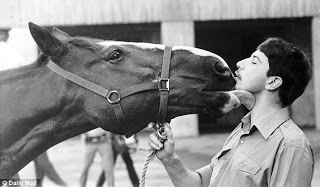
Sefton pictured after making a full recovery with trooper Michael Pedersen, also injured in the attack.
Born in Ireland, Sefton joined the Army in 1967. He was 16 hands high and spent the early years of his army career as a school horse, teaching new recruits to ride. in 1975, despite having socks and a blaze, he found his way into the Household Cavalry Mounted Regiment, which normally recruited only totally black horses. The Household Cavalry recorded that he was a horse of great courage and character. Trooper Pederson reported that Sefton responded so bravely when the bomb exploded that there was no chance of being thrown from him.
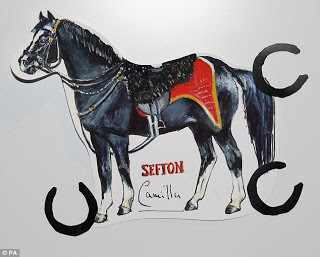
A watercolour painting done by the Duchess of Cornwall of Sefton for a 2011 exhibition War Horse: Fact and Fiction at central London's National Army Museum.
In 1984, Sefton was retired from the Household Calvary to The Home of Rest for Horses in Speen, Bucks, and stayed there until July 9, 1993. He became incurably lame from the injuries he suffered and was put to sleep at the age of 30. Sefton’s legacy remains through The British Horse Society Sefton Awards, set up in 1984, and there is the Sefton Equine Referral Unit, which is based at the Royal Veterinary College. Household Cavalry tradition dictates that horses' names are re-used, which ensures that Sefton’s memory will live on.
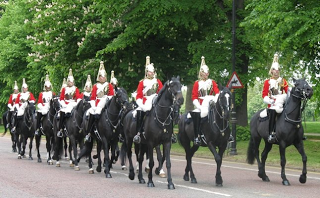
A monument to the tragedy that killed 11 people and seven horses, injured Sefton and eight of his stablemates, was erected on the spot where the bomb went off in Hyde Park and daily the troop honors it with an eyes left and a salute with drawn swords.
Published on July 19, 2012 00:23
July 16, 2012
All The Queen's Hats
In the past months, we have been watching Queen Elizabeth II at many events -- the wedding of her grandson, the Diamond Jubilee, and many annual ceremonial events. We are constantly fascinated by her lovely hats.
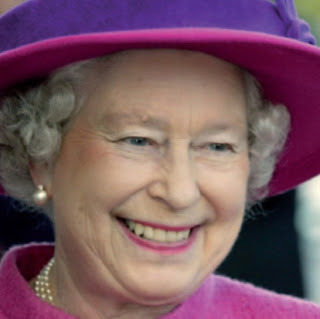
Her hats cannot cover up her face, since that is why people come out -- to see her! So that means none of the big brims or fluttery veils that can be so flattering. And since she so often is climbing in and out of limos, they can't be too big. Or in danger of blowing off. However, her milliners certainly manage to come up with a wonderful and colorful selection of styles -- here are a selection of our favorites.
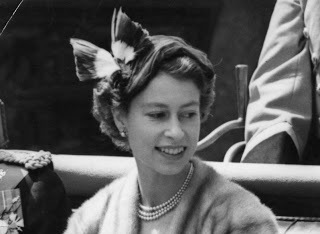
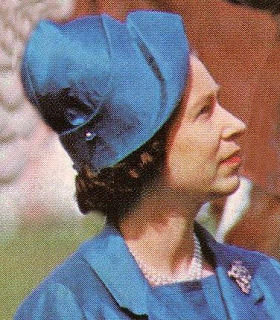
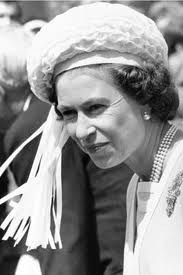
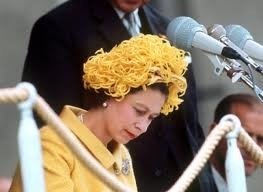
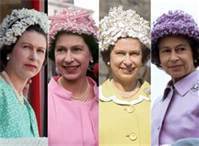
[image error] For the Silver Jubilee in 1977, The Queen's pink chapeau, decorated with 25 bells for the years in her reign, was designed by milliner Frederick Fox, who made more than 350 hats for Her Majesty.
[image error]
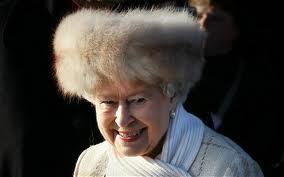
[image error] At the Wedding of Prince William and Catherine Middleton, 2011
[image error]
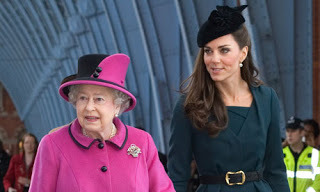 The Queen with the Duchess of Cambridge in Leicester
The Queen with the Duchess of Cambridge in Leicester
[image error] Boarding the Spirit of Chartwell for the Thames Procession
[image error] Both of the Queen's ensembles were created by her chief dresser-designer, Angela Kelly, who also made the creamy lemon outfit Her Majesty wore to the Royal Wedding.
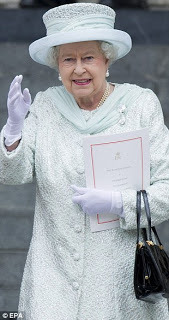 At the Silver Jubilee Service of Thanksgiving at St. Paul's Cathedral, 5 June, 2012
At the Silver Jubilee Service of Thanksgiving at St. Paul's Cathedral, 5 June, 2012
[image error]
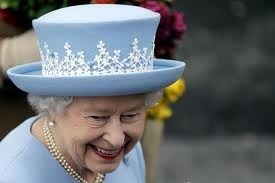 Queen Elizabeth II in Northern Ireland, June 26, 2012, in Wedgwood Blue
Queen Elizabeth II in Northern Ireland, June 26, 2012, in Wedgwood Blue
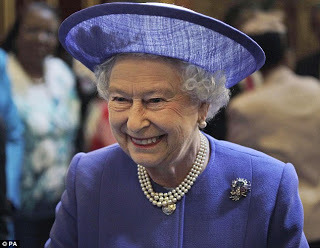
Below, the pink number that is Victoria's all-time favorite, worn at Ascot, 2011.
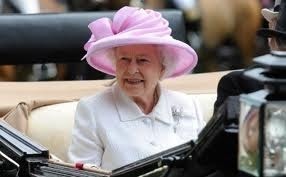
Another view below:
[image error]
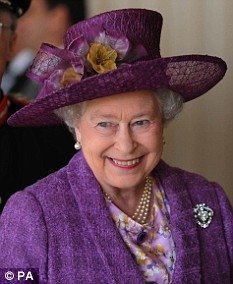
Trooping the Colour, 2011.
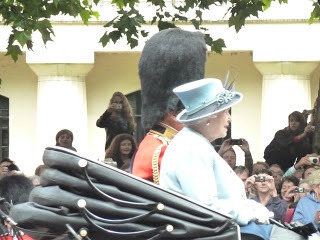
A rainbow of colo(u)r:
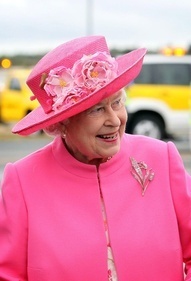
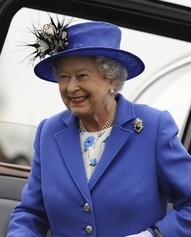 The Queen at Epsom Derby, this hat by Rachel Trevor Morgan
The Queen at Epsom Derby, this hat by Rachel Trevor Morgan
[image error] A paler blue hat by Philip Somerville, also a long-time milliner to Her Majesty
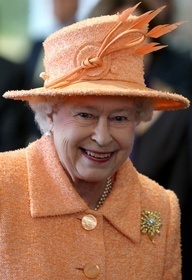
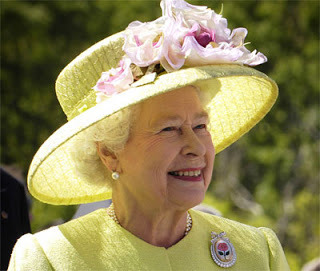
[image error]
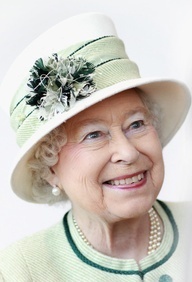
[image error]
[image error]
[image error]
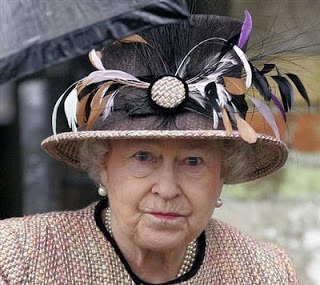
The Queen rarely wears beige, brown or black, being more visible in her favorite colorful couture, but there are exceptions!
[image error]
[image error] At Remembrance Day, November 13, 2011
Sometimes, while not on official duties, the Queen enjoys a headscarf!
[image error]
[image error] Regalia of the Order of the Garter
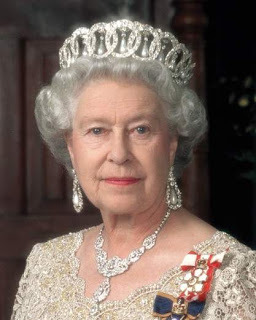 The Real Thing in Headware
The Real Thing in Headware
[image error] 9 May, 2012 opening Parliament


Her hats cannot cover up her face, since that is why people come out -- to see her! So that means none of the big brims or fluttery veils that can be so flattering. And since she so often is climbing in and out of limos, they can't be too big. Or in danger of blowing off. However, her milliners certainly manage to come up with a wonderful and colorful selection of styles -- here are a selection of our favorites.





[image error] For the Silver Jubilee in 1977, The Queen's pink chapeau, decorated with 25 bells for the years in her reign, was designed by milliner Frederick Fox, who made more than 350 hats for Her Majesty.
[image error]

[image error] At the Wedding of Prince William and Catherine Middleton, 2011
[image error]
 The Queen with the Duchess of Cambridge in Leicester
The Queen with the Duchess of Cambridge in Leicester[image error] Boarding the Spirit of Chartwell for the Thames Procession
[image error] Both of the Queen's ensembles were created by her chief dresser-designer, Angela Kelly, who also made the creamy lemon outfit Her Majesty wore to the Royal Wedding.
 At the Silver Jubilee Service of Thanksgiving at St. Paul's Cathedral, 5 June, 2012
At the Silver Jubilee Service of Thanksgiving at St. Paul's Cathedral, 5 June, 2012[image error]
 Queen Elizabeth II in Northern Ireland, June 26, 2012, in Wedgwood Blue
Queen Elizabeth II in Northern Ireland, June 26, 2012, in Wedgwood Blue
Below, the pink number that is Victoria's all-time favorite, worn at Ascot, 2011.

Another view below:
[image error]

Trooping the Colour, 2011.

A rainbow of colo(u)r:

 The Queen at Epsom Derby, this hat by Rachel Trevor Morgan
The Queen at Epsom Derby, this hat by Rachel Trevor Morgan[image error] A paler blue hat by Philip Somerville, also a long-time milliner to Her Majesty


[image error]

[image error]
[image error]
[image error]

The Queen rarely wears beige, brown or black, being more visible in her favorite colorful couture, but there are exceptions!
[image error]
[image error] At Remembrance Day, November 13, 2011
Sometimes, while not on official duties, the Queen enjoys a headscarf!
[image error]
[image error] Regalia of the Order of the Garter
 The Real Thing in Headware
The Real Thing in Headware[image error] 9 May, 2012 opening Parliament
Published on July 16, 2012 23:54
Kristine Hughes's Blog
- Kristine Hughes's profile
- 6 followers
Kristine Hughes isn't a Goodreads Author
(yet),
but they
do have a blog,
so here are some recent posts imported from
their feed.



